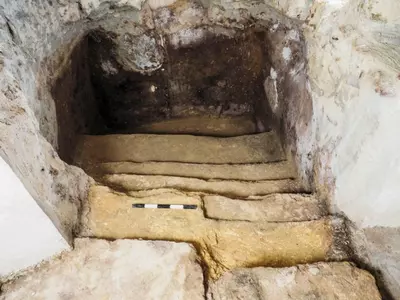UK Archaeologist Claims To Have Found Jesus Christ's Childhood Home In Israel

An archaeologist from the UK has claimed to have uncovered Jesus Christ's 'childhood home' during an excavation in Nazareth. Professor Ken Dark, an archaeologist from the University of Reading, made the claim in his new book.
Professor Dark has spent more than 14 years studying the remains of a dwelling under the Sisters of Nazareth Convent in Nazareth, Israel.
Also read: Archaeologists Find 59 Coffins In Egypt Sealed 2,500 Years Ago
 Twitter
Twitter
The dwelling dates back to the 1st century and is believed to have been built by Saint Joseph, the husband of the Virgin Mary and Jesus Christ's father on Earth. He was known to be a highly-skilled craftsman.
According to reports, the dwelling is located near the Church of Annunciation and was first discovered back in the 1880s. Many experts over the years have said that churches were built on top so that it's significance could be preserved.
Professor Dark's new book titled The Sisters of Nazareth Convent shares details about how nuns of the Sisters of Nazareth Convent carried out excavations at the site under orders from the Mere Giraud, the mother superior of the convent.
Also read: Dismembered Bodies, No Graves: Archaeologists Find Skeletons Of Massacre Victims In Iron Age
 Twitter
Twitter
Several reports claimed that excavations at the site were carried out until the 1930s, with nuns believing the dwelling was the home where Jesus grew up. However, there was never any hard evidence to prove their beliefs, which were mostly drawn from theories by biblical scholar Victor Guérin, back in 1888.
In the following years, between 1936 and 1964, several excavations took place at the site. The most prominent ones were by a Jesuit priest called Henri Senès.
Apart from new excavations, Senès created detailed drawings of the structures discovered by the nuns before him. He was able to do so as he was an architect before becoming a priest.
However, he didn't publish any academic papers about his findings.
Professor Dark got drawn into the project in 2006, and in 2015, he wrote an article about his initial findings.
Also read: Archaeologists Discover More Than 200-Year-Old Shipwreck In Mexico's Caribbean
 Twitter
Twitter
“The first-century house is associated with broken sherds of cooking pots and a spindle whorl used in a spinning thread. We also found what may be pieces of limestone vessels suggesting a Jewish family lived in the house – during the first-century Jewish beliefs held that limestone could not become impure,” he had written at the time.

























